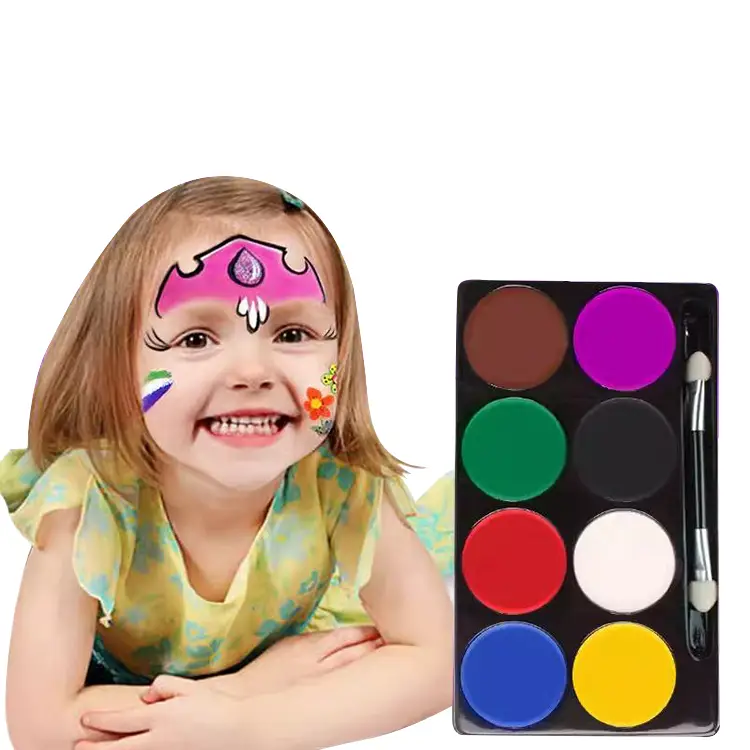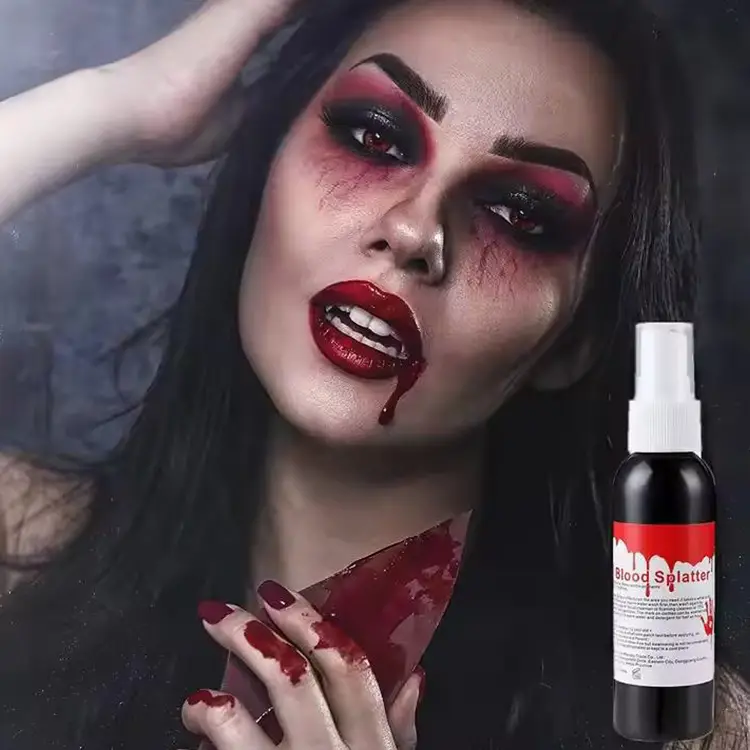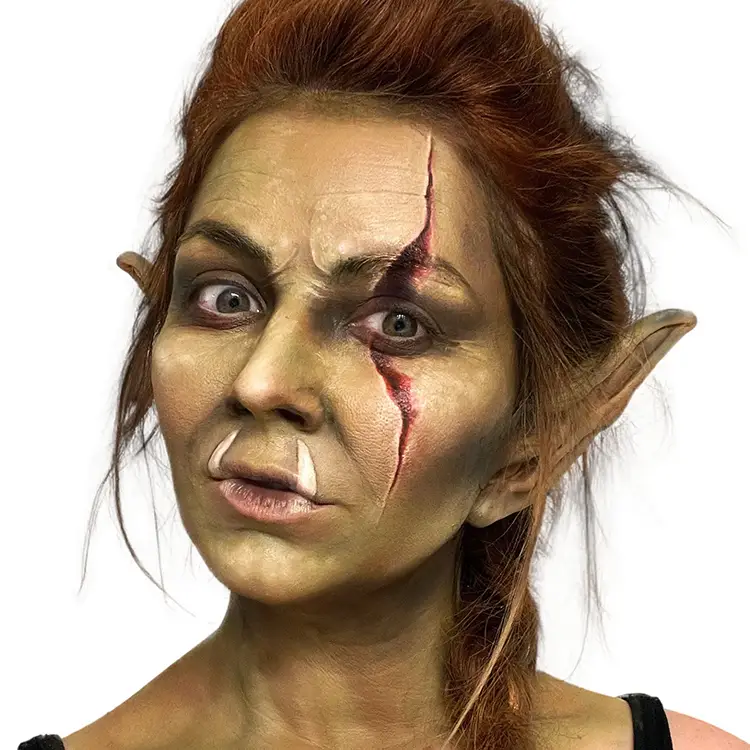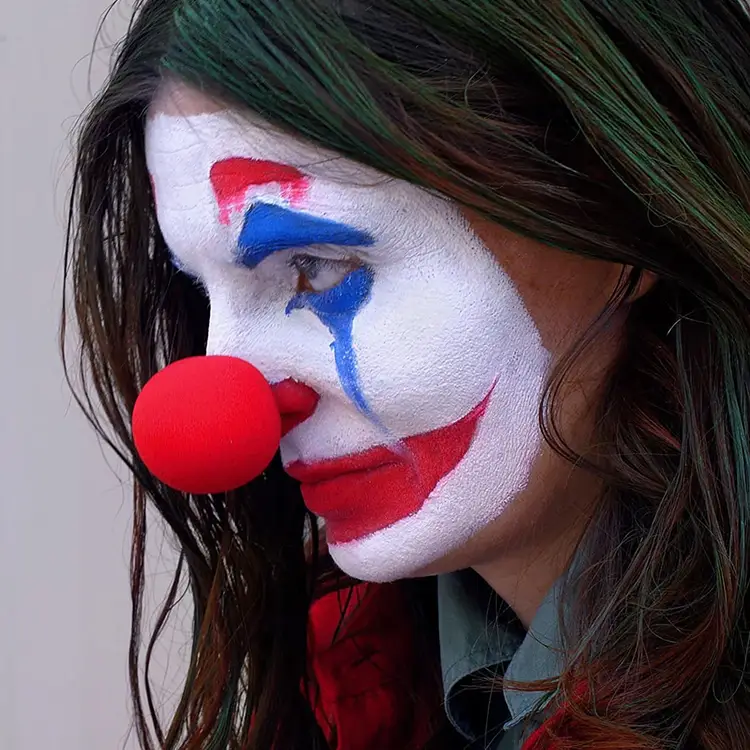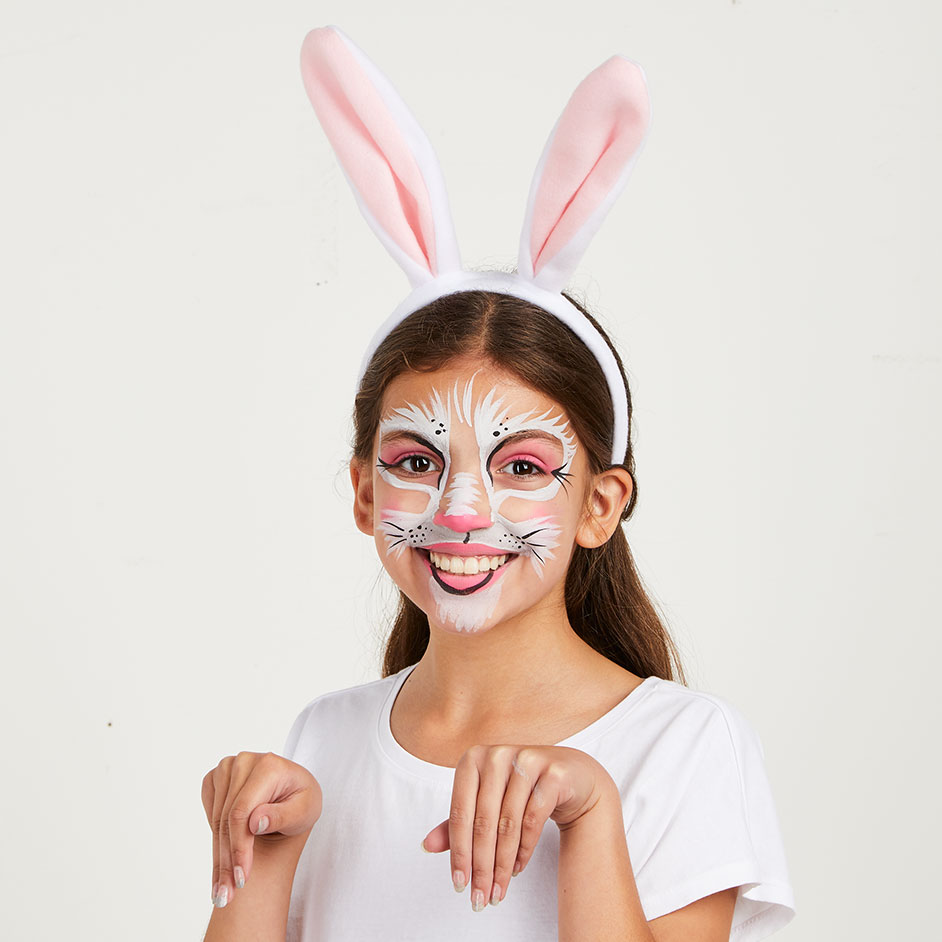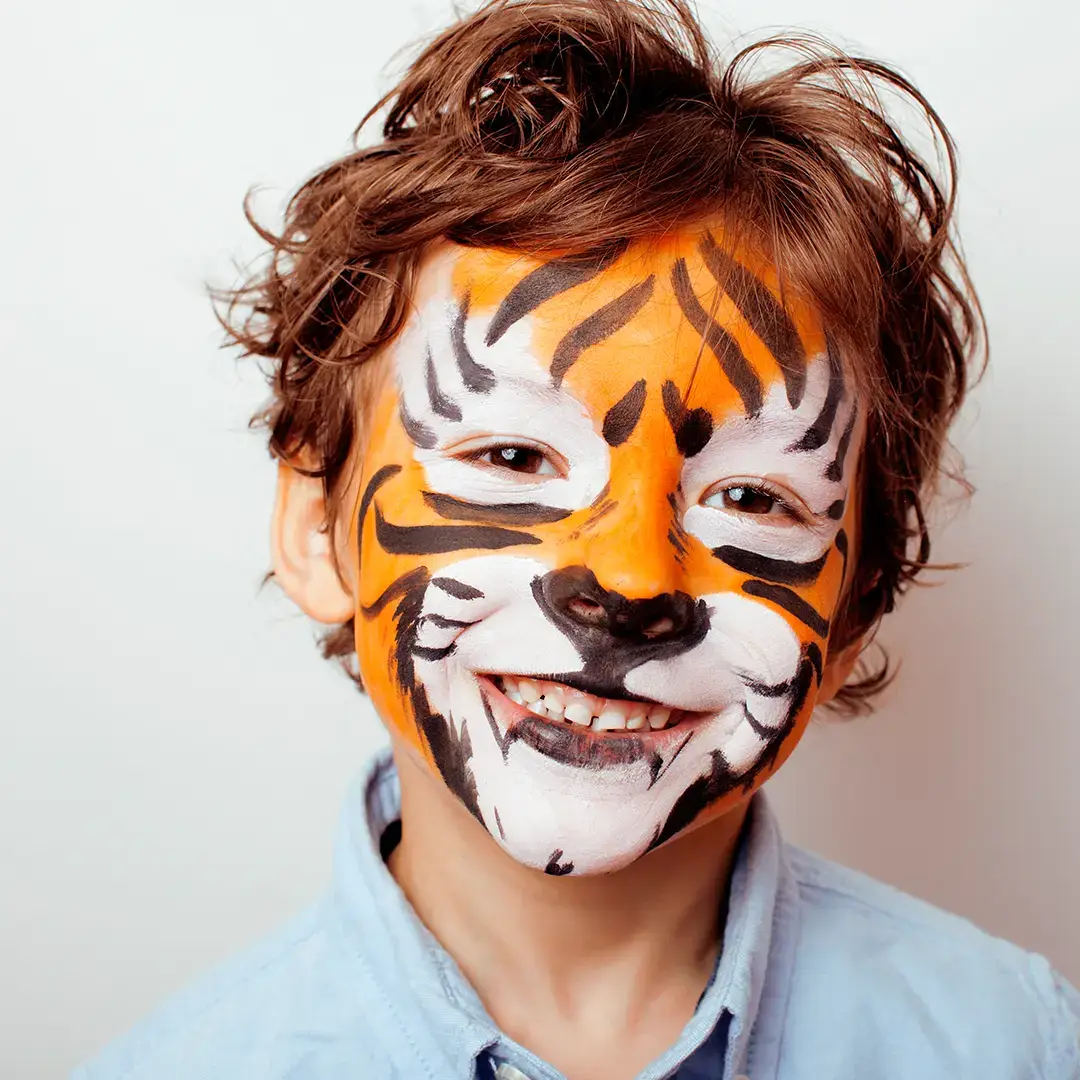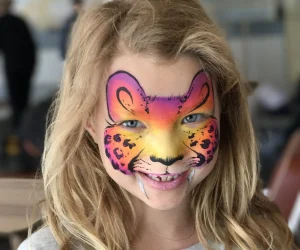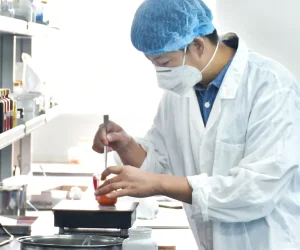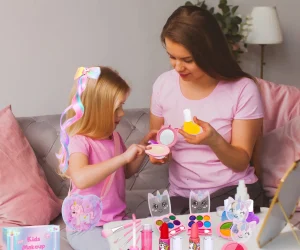How to Do Easy Halloween Makeup for Kids: Fun and Safe Ideas
Table of Contents
Halloween makeup can be a fun part of the holiday, but when it comes to kids, it’s not just about looks. Their skin, their attention span, and their safety all matter. Easy and safe makeup isn’t just convenient—it’s essential.
Understanding Children’s Skin Sensitivity
Children’s skin is thinner than that of adults and has a weaker barrier function (Kelleher et al., Pediatric Dermatology, 2015). This means it can absorb chemicals more easily and may react quickly to irritants. Many Halloween face paints or costume cosmetics are made with dyes, fragrances, or preservatives that may cause redness, rashes, or itching.
Even so-called “natural” products aren’t always safe. For example, citrus oils and mica-based glitters can still irritate delicate areas like the eyelids or cheeks. Always test makeup on a small patch before applying it fully.
Choosing Age-Appropriate Makeup Styles
A vampire with dark eye sockets might look cool on an adult—but on a toddler, it can feel overwhelming or even scary. Age-appropriate Halloween makeup means more than avoiding complex looks; it’s about creating something simple, soft, and comfortable to wear.
For younger kids, animal faces like a puppy or kitty are easy to draw and friendly-looking. Older kids might enjoy being a pumpkin or ghost, which can be done with a few brush strokes and still feel festive. Keep the focus on creativity, not perfection.
The Benefits of Using Minimal Products for Young Faces
Less is more, especially when it comes to young skin. Using fewer products lowers the chance of skin irritation, smudging, or discomfort. It also shortens the time kids need to sit still—always a bonus.
One mom shared that her 4-year-old refused to sit still for more than three minutes. She used just white face paint, a black pencil, and pink blush to create a cute skeleton. Her daughter loved it, and it lasted all evening.
Stick to basics: a clean sponge, one or two colors, and a steady hand. You’ll be surprised how much you can do with so little.
Must-Know Safety Tips Before Applying Halloween Makeup on Kids
Before reaching for the makeup brush, it’s important to think about what’s going on your child’s face. Halloween makeup should be as safe as it is fun. This starts with knowing what’s in the product, how it may affect sensitive skin, and how to handle any issues that come up.
Check for Hypoallergenic and Non-Toxic Ingredients
Always read the label. Look for products labeled hypoallergenic, non-toxic, and FDA-approved for skin use. But even those aren’t perfect. The term “hypoallergenic” isn’t tightly regulated in all countries, so it’s not a guarantee your child won’t react.
Avoid products with parabens, formaldehyde releasers, or fragrance mixes, which are among the top skin sensitizers in cosmetics (American Contact Dermatitis Society, 2019). If the ingredient list is too long or contains words you can’t pronounce, it may be worth skipping.
Patch Testing: How and Why to Do It
Before Halloween night, do a patch test. It only takes a few minutes but could save hours of discomfort. Here’s how:
- Apply a small amount of makeup behind your child’s ear or on their inner arm.
- Leave it on for 24 hours.
- Watch for redness, bumps, or itchiness.
Even if the product seems mild, reactions can happen—especially when mixed with sweat or left on too long. A patch test offers a quiet early warning.
Avoiding Common Allergens in Kids’ Makeup
Some ingredients are known to cause more trouble than others. Nickel, lanolin, essential oils, and glitter made from metal are all high-risk for sensitive skin. Even “natural” makeup can contain ingredients like cinnamon oil or citrus extracts that may irritate young skin.
When in doubt, skip scented or shimmery products. Fragrance is one of the most common causes of allergic contact dermatitis in children (Dermatitis Journal, 2020).
What to Do in Case of a Reaction
If your child starts showing signs of a reaction—redness, itching, swelling—remove the makeup immediately using a gentle cleanser and cool water. Do not scrub. Apply a fragrance-free moisturizer and monitor the area.
For mild irritation, an over-the-counter hydrocortisone cream (0.5% or 1%) may help, but only use it on the advice of a pediatrician. If swelling worsens or spreads, seek medical help right away. It’s always better to overreact than to overlook.
Basic Tools and Materials for Easy Halloween Makeup for Kids
You don’t need a professional makeup kit to create fun Halloween looks for kids. With just a few simple tools and materials, you can achieve safe, colorful, and creative results at home. The trick is knowing what to use—and what to avoid.
Essential Brushes, Sponges, and Applicators
Softness matters. Choose brushes with synthetic bristles—they’re easier to clean and less likely to irritate the skin. Use small brushes for detail work (like whiskers or spider webs) and flat sponges for covering larger areas quickly.
For blending, rounded beauty sponges work well, but only if they’re clean and dry. Always wash tools before and after use to avoid bacteria buildup. Dirty applicators are one of the easiest ways to cause breakouts or infections.
Face Paint vs. Makeup: What’s Better for Kids?
Both can work, but they serve different purposes.
Face paint is often water-based, easy to remove, and made for short-term wear. It’s a good pick for bold colors and simple shapes. Many kits are labeled non-toxic and safe for kids, but always read the fine print.
Makeup, like cream-based blush or eyeshadow, may last longer and offer more subtle effects—but it often contains preservatives and pigments that aren’t meant for children’s skin. Avoid adult products unless they’re certified for sensitive use.
So which is better? If you’re painting a tiger face or a fairy butterfly, go with kid-safe face paint. If it’s just rosy cheeks or light shading, gentle makeup may be fine.
Optional Add-ons: Stencils, Glitter, and Stickers
These extras can add flair, but they also add risk.
Stencils are helpful for quick, clean designs—just make sure they’re made of soft plastic and don’t press too hard on the skin.
Glitter might look magical, but avoid craft glitter. Only use cosmetic-grade glitter, and never near the eyes. Small particles can scratch the cornea or cause irritation if inhaled.
Stickers and gems should be labeled skin-safe and latex-free. Don’t use glue meant for crafts—use a gentle skin adhesive if needed. And remember: kids sweat, and things can slide. Keep a mirror and wipes nearby.
Step-by-Step Guide to Simple Halloween Makeup Looks for Kids
Halloween makeup for kids doesn’t need to be complicated. A few colors, simple shapes, and soft brushes can go a long way. Below are some easy, non-scary ideas to get you started. Each look uses minimal products and keeps comfort top of mind—because a happy child wears their costume longer!
Cute Cat or Kitten Face
This is a go-to classic and takes just a few steps.
- Start with a clean face. Use a sponge to dab on light pink or beige for a base.
- Add whiskers using a thin brush and black face paint—three short lines on each cheek.
- Draw a small nose—a triangle or heart shape on the tip of the nose works well.
- Line the top eyelids with black (if your child is okay with it), then flick out a tiny “cat-eye” wing.
- Optional: Add little white dots above the whiskers for extra cuteness.
Let them wear a headband with ears, and you’ve got a meowing success.
Friendly Pumpkin Face
Bright and cheerful—not spooky.
- Apply orange face paint in a circle shape over the cheeks or entire face.
- Use black or brown to gently outline pumpkin ridges—draw 3–4 curved lines.
- Add a green “stem” at the top center of the forehead using green paint.
- Optional: Add tiny white dots or gold to mimic a shiny, bouncy pumpkin.
This look is perfect for toddlers who want to look festive without any frights.
Classic Ghost or Skeleton (Non-Scary Version)
Keep it playful, not spooky.
- Start with a white base all over the face using a sponge.
- Draw two big black circles around the eyes—make them rounded and soft.
- Add a smiling mouth—use black to draw a wide grin with gentle stitch marks.
- Optional: Add light blue or purple around the edges for a magical “glow” effect.
This is great for kids who like skeletons but don’t want to look too creepy.
Easy Witch or Wizard Look
No green face paint needed.
- Draw a star or crescent moon on one cheek using purple, silver, or gold.
- Add some eye sparkle with purple eyeshadow or kid-safe shimmer.
- Use black paint to create a swirl or lightning bolt across the forehead or side of the face.
- Optional: Add fake freckles, glitter eyebrows, or a tiny spider web on the chin.
Add a hat and robe, and your mini spell-caster is ready for trick-or-treating.
Tips for Quick Transitions Between Looks
Kids change their minds—fast.
- Use makeup wipes or micellar water for quick removal.
- Choose neutral base colors like white or beige so you can build or change designs.
- Have baby powder or translucent setting powder on hand—it helps makeup last but also absorbs sweat when reapplying.
- Keep extra sponges and small brushes nearby for touch-ups or new designs.
The goal? Keep things light, easy, and fun. No meltdown needed between makeovers.
How to Make Halloween Makeup Last Without Irritating Kids’ Skin
Kids move. They sweat. They touch their faces. That means Halloween makeup can smudge fast—and sometimes irritate young skin. But with a little prep and the right products, you can help the look stay put without causing redness or discomfort. Here’s how to keep things fun, long-lasting, and gentle.
Prepping the Face: Gentle Cleansing and Moisturizing
Before you even open the makeup bag, start with a clean face. Use a mild cleanser—something unscented and made for sensitive skin. This removes oils and dirt that could make makeup slide off.
After cleansing, apply a fragrance-free moisturizer. A light lotion helps create a soft surface, making makeup go on smoother. It also acts as a buffer between the skin and face paint, especially if the child will be wearing makeup for several hours.
Using Lightweight Primers or Natural Barriers
Primers aren’t just for adults. A kid-safe, lightweight primer (gel or lotion) helps makeup stick better and resist smudging. But if you’re not comfortable using commercial primers on young skin, try natural alternatives:
- Aloe vera gel (pure, no additives) works well as a breathable base layer.
- Zinc oxide cream can act as a mild barrier and is commonly used in diaper creams—just use a very thin layer.
Avoid anything with silicones or heavy oils, which can clog pores and trap sweat.
Setting the Look with Child-Safe Products
Once the makeup is applied, keep it in place with a light setting powder. Cornstarch-based powders (some baby powders) are often gentler than traditional setting powders made for adults.
Avoid aerosol sprays, which often contain alcohol or strong fragrance. Instead, use:
- A makeup setting spray labeled safe for kids, if available.
- A DIY option: Mix a small amount of rose water and glycerin in a spray bottle (test first to avoid irritation).
Always keep tissues or blotting paper nearby. They help control shine and sweat—without rubbing everything off.
Removing Halloween Makeup from Kids’ Skin the Right Way
After the fun of trick-or-treating comes the cleanup. Removing Halloween makeup may seem like an afterthought, but doing it gently matters—especially for young, sensitive skin. Scrubbing too hard or using harsh products can cause dryness, redness, or even breakouts. Here’s how to remove makeup the safe and soothing way.
Why Gentle Removal Is Crucial
Children’s skin is thinner and more delicate than adult skin. It loses moisture faster and reacts more easily to irritants. Rubbing or using strong cleansers can strip the skin’s natural oils, leaving it dry or irritated.
Some Halloween products—especially face paints or glitter—can cling to the skin. That doesn’t mean you need stronger products. It just means you need the right steps and a little patience.
Step-by-Step Makeup Removal for Delicate Skin
Step 1: Soften the Makeup
Use a gentle cleansing oil or micellar water made for sensitive skin. Apply it with a soft cotton pad or fingertips. Let it sit for a few seconds to break down the makeup.
Step 2: Wipe, Don’t Scrub
Gently wipe in small circles. For tricky spots like glitter or around the eyes, use a cotton swab soaked in remover. Never rub hard, even if some color remains.
Step 3: Cleanse with Mild Soap
After the makeup is mostly off, use a fragrance-free facial cleanser made for children or sensitive skin. Rinse with lukewarm water—not hot.
Step 4: Pat Dry
Use a clean, soft towel to pat the skin dry. Avoid rubbing the face with rough clothes.
Post-Makeup Skincare Routine for Children
Even gentle removal can leave skin a little tired. After cleansing, apply a child-safe moisturizer to help restore balance. Look for products with calming ingredients like:
- Aloe vera
- Chamomile
- Calendula
Avoid heavy creams or anything with strong fragrance. If you notice redness or irritation the next day, skip skincare products and let the skin breathe. A cool compress can help soothe any lingering discomfort.
For glitter or costume adhesives, you may need a few extra days of gentle cleansing. Never try to peel or scratch anything off the skin.
Common Mistakes to Avoid When Doing Halloween Makeup for Kids
Even with the best intentions, small missteps can turn fun Halloween makeup into an uncomfortable experience. Whether you’re trying out a spooky skeleton or a sparkly unicorn, it’s easy to overlook how kids react to certain products, textures, or designs. Let’s walk through the most common mistakes—and how to steer clear of them.
Using Adult Products on Young Skin
Adult makeup often contains stronger pigments, fragrances, or preservatives not meant for children’s sensitive skin. Foundations, eye shadows, and lipsticks designed for adults may clog pores or trigger reactions in kids.
Instead, choose products labeled as hypoallergenic, non-toxic, and specifically tested for children. Even if a product looks mild, check the ingredients list—avoid alcohol, parabens, and artificial dyes when possible.
Applying Too Much Product
It might be tempting to layer on colors or add bold designs for dramatic effect, but less is usually better. Kids sweat, touch their faces, and move around a lot, making heavy makeup more likely to smudge or irritate.
Stick to simple designs with minimal layering. A few well-placed lines and colors can go a long way. For example, a simple cat face with whiskers and a nose might be more enjoyable (and longer-lasting) than a fully painted tiger face.
Ignoring Comfort and Mobility in Makeup Design
Kids are active. If your design covers the eyes, mouth, or tight areas like the neck, it could make them uncomfortable or interfere with movement. Avoid makeup near the waterline or on lips if your child will be eating candy, talking a lot, or running around.
Ask kids how the makeup feels as you apply it. If they say it’s itchy, sticky, or tight, don’t ignore it. Choose lightweight designs that allow them to move, smile, and play freely without worrying about smears or discomfort.
Weather and Time Considerations for Kids’ Halloween Makeup
When planning Halloween makeup for kids, it’s easy to focus on the look—but the weather and how long they’ll wear it matter just as much. Hot or cold, dry or damp—different conditions affect how makeup behaves on young skin. And since kids are likely to wear it for hours while moving, playing, and snacking, durability and comfort become key.
Adjusting Makeup for Warm or Cold Weather
In warm weather, kids may sweat more, especially if they’re in costumes with hats or masks. Sweating can cause face paint to melt or smear. To help with this:
- Use water-based paints sparingly and let each layer dry fully.
- Skip heavy cream products in favor of light, fast-drying formulas.
- Gently blot the face with tissue before applying makeup.
In cold weather, the skin can get dry or chapped. That means makeup may flake or crack—especially around the nose or mouth. To help:
- Moisturize well before starting.
- Use cream-based products that offer a bit more flexibility and hydration.
- Avoid powders, which can make dry skin look worse.
Layering a light balm or lotion underneath the makeup can act as a barrier in either climate.
Choosing Looks That Stay Put During Play and Trick-or-Treating
Kids don’t stay still. They run, snack, roll on the floor, and wipe their faces without thinking. That means even the best design can wear off fast.
To keep makeup in place:
- Choose simple, high-impact designs like a bold nose and whiskers instead of full-face coverage.
- Apply a thin setting powder or child-safe fixative spray if possible.
- Avoid placing makeup too close to the eyes, mouth, or areas where costume parts (like hats or hoods) will rub.
Plan for quick fixes. Bring a travel-sized makeup remover, a small brush, and touch-up paint in case something smears during a school party or while trick-or-treating.
Encouraging Creativity: Letting Kids Participate in the Makeup Process
Halloween makeup can be more than just getting ready—it’s a chance to spark creativity and teach kids about self-expression and care. Involving children in the process helps them feel proud and excited about their look while learning skills that go beyond the holiday.
Making It a Fun and Educational Activity
Turn makeup time into a playful lesson. Let kids choose colors, shapes, or characters they want to try. Talk about colors and how they mix, or the story behind the costume they picked. This makes makeup feel less like a chore and more like a creative project.
For example, ask, “What do you think a friendly ghost looks like?” and help them design their own version. This boosts imagination and confidence.
Teaching Basic Application and Hygiene
Kids can learn simple makeup skills that also teach responsibility. Show them how to:
- Use clean brushes or sponges.
- Apply makeup gently without rubbing.
- Avoid sharing products with friends to prevent germs.
Explaining why hygiene matters can make kids more mindful and careful—not just during Halloween but year-round.
Supporting Kids’ Costume and Character Ideas
Encourage children to express who they want to be, whether it’s a witch, a superhero, or an animal. Even if their idea is tricky to recreate, find ways to simplify the makeup while keeping the spirit of their vision.
Sometimes a few dots, stripes, or a splash of color can bring a character to life better than a full face of paint. Listening to their ideas respects their creativity and makes the experience more rewarding.
Conclusion
Creating easy Halloween makeup for kids means balancing fun with safety and comfort. By choosing gentle products, simple designs, and involving children in the process, you make the experience enjoyable and memorable. After all, Halloween is about joy and creativity—no stress required!
FAQ
Use gentle, fragrance-free makeup removers like micellar water and soft cotton pads. Let the remover sit on the skin for a few seconds to loosen makeup, then gently wipe without rubbing. Turning it into a calming game or story can also help keep kids still during removal.
Yes! Consider using hypoallergenic face stickers, washable tattoos, or colored hair chalk as fun, low-risk options. These avoid direct skin contact with pigments and reduce the chance of irritation while still allowing creative expression.
Apply makeup carefully, avoiding the waterline and eyelids whenever possible. Use brushes or sponges rather than fingers for precision. Also, choose products formulated specifically for sensitive eye areas and remind kids not to rub their eyes while wearing makeup.
It’s best to limit makeup wear to a few hours, ideally no more than 4-6 hours. Prolonged wear can increase irritation risk, especially if kids sweat or touch their faces often. Always remove makeup as soon as the event ends to protect skin health.
Children with known allergies should only use makeup products free from their triggers, such as fragrance-free or gluten-free formulas. Always do a patch test at least 24 hours before use and consult with a pediatrician if unsure about any ingredients.

